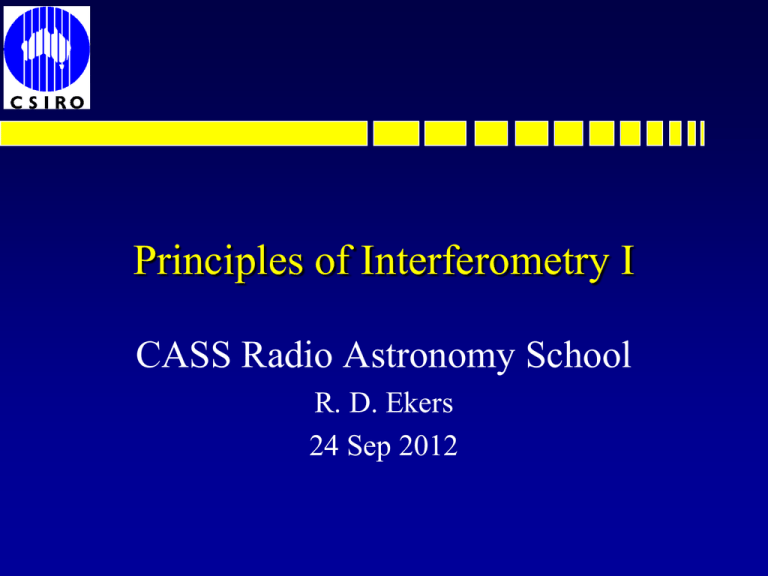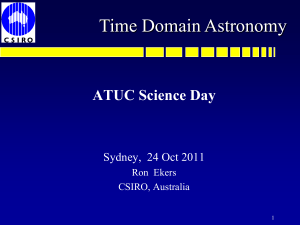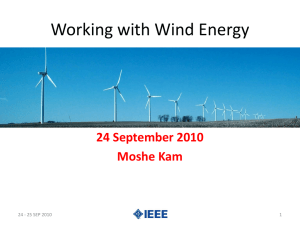Principles of Interferometry I - Australia Telescope National Facility
advertisement

Principles of Interferometry I CASS Radio Astronomy School R. D. Ekers 24 Sep 2012 WHY? Importance in radio astronomy – ATCA, VLA, WSRT, GMRT, MERLIN, IRAM... – VLBA, JIVE, VSOP, RADIOASTON – ALMA, LOFAR, MWA, ASKAP, MeerKat, SKA 292Sep 2012 R D Ekers 2 Cygnus region - CGPS (small) Radio Image of Ionised Hydrogen in Cyg X CGPS (Penticton) 29 Sep 2008 R D Ekers 3 Cygnus A Raw data VLA continuum Deconvolution correcting for gaps between telescopes Self Calibration adaptive optics 29 Sep 2008 R D Ekers 4 WHY? Importance in radio astronomy – ATCA, VLA, WSRT, GMRT, MERLIN, IRAM... – VLBA, JIVE, VSOP, RADIOASTRON – ALMA, LOFAR, ASKAP, SKA AT as a National Facility easy to use don’t know what you are doing Cross fertilization Doing the best science 29 Sep 2008 R D Ekers 5 Indirect Imaging Applications Interferometry – radio, optical, IR, space... Aperture synthesis – Earth rotation, SAR, X-ray crystallography Axial tomography (CAT) – NMR, Ultrasound, PET, X-ray tomography Seismology Fourier filtering, pattern recognition Adaptive optics, speckle 24 Sep 2012 R D Ekers Antikythera 6 Doing the best science The telescope as an analytic tool – how to use it – integrity of results Making discoveries – Most discoveries are driven by instrumental developments – recognising the unexpected phenomenon – discriminate against errors Instrumental or Astronomical specialization? 29 Sep 2008 R D Ekers 7 HOW ? Don’t Panic! – Many entrance levels 29 Sep 2008 R D Ekers 8 Basic concepts Importance of analogies for physical insight Different ways to look at a synthesis telescope – Engineers model » Telescope beam patterns… – Physicist em wave model » Sampling the spatial coherence function » Barry Clark Synthesis Imaging chapter1 » Born & Wolf Physical Optics – Quantum model » Radhakrishnan Synthesis Imaging last chapter 29 Sep 2008 R D Ekers 9 Spatial Coherence P1 P1 & P2 spatially incoherent sources At distant points Q1 & Q2 The field is partially coherent P2 Q1 Q2 van Cittert-Zernike theorem The spatial coherence function is the Fourier Transform of the brightness distribution 29 Sep 2008 R D Ekers 10 Physics: propagation of coherence • Radio source emits independent noise from each element • Electrons spiraling around magnetic fields • Thermal emission from dust, etc. • As electromagnetic radiation propagates away from source, it remains coherent • By measuring the correlation in the EM radiation, we can work backwards to determine the properties of the source • Van Cittert-Zernicke theorem states that the • Sky brightness and Coherence function are a Fourier pair • Mathematically: j . 2 . ul vm V (u, v) I (l , m) e dl.dm •11 Physics: propagation of coherence • Simplest example – Put two emitters (a,b) in a plane – And two receivers (1,2) in another plane V1r Vae . g1a Vbe . g1b V2r Vae . g 2a Vbe . g 2b • Correlate voltages from the two receivers V1r .V2r Vae .g1a Vbe .g1b Vae .g2a Vbe .g2b Vae .Vae .g2a .g1a Vbe .Vbe .g2b .g1b I a .g2a .g1a I b .g2b .g1b • Correlation contains information about the source I • Can move receivers around to untangle information in g’s •12 Analogy with single dish Big mirror decomposition 23 Sep 2012 R D Ekers 13 14 15 Free space Guided ( Vi )2 16 Free space Guided ( Vi )2 17 Free space Guided Delay Phased array ( Vi )2 18 Free space Guided Delay Phased array ( Vi )2 19 Free space Guided Delay Phased array ( Vi )2 = (Vi )2 + (Vi Vj ) 20 Free space Guided Ryle & Vonberg (1946) phase switch Delay Phased array ( Vi )2 = (Vi )2 + (Vi Vj ) Correlation array 21 22 Phased Array Split signal x2 x2 x2 x2 x2 x2 no S/N loss t Phased array Tied array Beam former ( Vi )2 ( Vi )2 I() I 24 Synthesis Imaging t correlator = t/ <Vi Vj> Fourier Transform I(r) van Cittert-Zernike theorem 25 Analogy with single dish Big mirror decomposition Reverse the process to understand imaging with a mirror – Eg understanding non-redundant masks – Adaptive optics Single dishes and correlation interferometers – Darrel Emerson, NRAO – http://www.gb.nrao.edu/sd03/talks/whysd_r1.pdf 23 Sep 2012 R D Ekers 26 Filling the aperture Aperture synthesis – measure correlations sequentially – earth rotation synthesis – store correlations for later use Redundant spacings – some interferometer spacings twice Non-redundant aperture Unfilled aperture – some spacings missing 29 Sep 2008 R D Ekers 27 Redundancy 1unit 5x 2units 4x 3units 3x 4units 2x 5units 1x n(n-1)/2 = 15 1 2 3 4 5 6 Non Redundant 1unit 1x 2units 1x 3units 1x 4units 1x 5units 0x 6units 1x 7units 1x etc 1 2 3 4 5 6 7 8 Basic Interferometer 29 Sep 2008 R D Ekers 30 Storing visibilities Can manipulate the coherence function and re-image Storage 29 Sep 2008 R D Ekers 31 Fourier Transform and Resolution Large spacings – high resolution Small spacings – low resolution 29 Sep 2008 R D Ekers 32 Fourier Transform Properties from Kevin Cowtan's Book of Fourier FT FT http://www.ysbl.york.ac.uk/~cowtan/fourier/fourier.html Fourier Transform Properties FT 10% data omitted in rings Fourier Transform Properties FT Amplitude of duck Phase of cat Fourier Transform Properties FT Amplitude of cat Phase of duck In practice… 1. Use many antennas (VLA has 27) 2. Amplify signals 3. Sample and digitize 4. Send to central location 5. Perform cross-correlation 6. Earth rotation fills the “aperture” 7. Inverse Fourier Transform gets image 8. Correct for limited number of antennas 9. Correct for imperfections in the “telescope” e.g. calibration errors 10. Make a beautiful image… •37 Aperture Array or Focal Plane Array? Why have a dish at all? – Sample the whole wavefront Computer – n elements needed: n Area/( λ/2)2 – For 100m aperture and λ = 20cm, n=104 » Electronics costs too high! Phased Array Feeds – Any part of the complex wavefront can be used – Choose a region with a smaller waist – Need a concentrator 29 Sep 2008 R D Ekers 38 Find the Smallest Waist use dish as a concentrator D2 D1 D1 < D2 n1 < n 2 29 Sep 2008 R D Ekers 39 Radio Telescope Imaging image v aperture plane λ Computer Dishes act as concentrators Reduces FoV Reduces active elements Cooling possible Computer 29 Sep 2008 Active elements ~ A/λ2 Increase FoV Increases active elements R D Ekers 40 Analogies RADIO grating responses OPTICAL aliased orders primary beam direction grating blaze angle UV (visibility) plane hologram bandwidth smearing chromatic aberration local oscillator reference beam 29 Sep 2008 R D Ekers 41 Terminology RADIO OPTICAL Antenna, dish Telescope, element Sidelobes Diffraction pattern Near sidelobes Airy rings Feed legs Spider Aperture blockage Vignetting Dirty beam Point Spread Function (PSF) Primary beam Field of View 22 Sep 2012 R D Ekers 42 Terminology RADIO OPTICAL Map Image Source Object Image plane Image plane Aperture plane Pupil plane UV plane Fourier plan Aperture Entrance pupil UV coverage Modulation transfer function 22 Sep 2012 R D Ekers 43 Terminology RADIO OPTICAL Dynamic range Contrast Phased array Beam combiner Correlator no analog no analog Correlator Receiver Detector Taper Apodise Self calibration Wavefront sensing (Adaptive optics) 22 Sep 2012 R D Ekers 44






